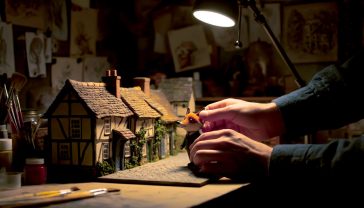The Ale Trail: A Rambler’s Guide to Britain’s Finest Pubs and Their Storied Brews
Your ultimate guide to the Great British ale trail. Explore the history of the pub, understand real ale, and discover the best routes and inns across the UK.

This post may contain affiliate links. If you make a purchase through these links, we may earn a commission at no additional cost to you.
There’s a certain magic to a proper British pub. It’s more than just a place that sells beer. It’s the gentle hum of conversation, the clink of glasses, the smell of old wood and beer-soaked hops, and the welcoming glow of a fire on a rainy afternoon. It’s a community’s living room, a place for celebration and commiseration, for quiet reflection and loud laughter. And at the heart of this institution is the ale—the drink that has shaped our history, our culture, and our landscape.
Embarking on an ale trail is one of the best ways to explore this rich heritage. It’s a journey through Britain’s past and present, a pilgrimage from one brilliant pub to the next in search of the perfect pint. This isn’t just about drinking; it’s about discovering hidden gems, walking through stunning countryside, and understanding what makes the British pub a national treasure. So, grab a metaphorical seat by the fire, and let’s explore the wonderful world of Britain’s pubs and their storied brews.
What Exactly Is an Ale Trail?
At its simplest, an ale trail is a planned route that connects a series of pubs, usually on foot or by public transport. Think of it as a treasure hunt for adults, where the prize at each stop is a beautifully kept pint of local ale. But it’s much more than just a pub crawl. A good ale trail tells a story. It might follow an old drover’s road, a scenic railway line, or a path through a city’s most historic streets.
From Planned Routes to Happy Accidents
Some ale trails are famous and well-trodden. The Transpennine Real Ale Trail, for example, uses a railway line to link a series of fantastic pubs between Manchester and Yorkshire. Others are routes you create yourself—a ramble through the Cotswolds, punctuated by stops at honey-stone inns, or a wander through London’s backstreets, discovering pubs that have stood for centuries.
The best trails, however, often involve a bit of both planning and spontaneity. You might have a destination in mind, but the real joy comes from the unexpected detours—the little backstreet boozer you stumble upon by accident, the local landlord who tells you a story, or the unique seasonal beer you’ve never tried before.
Real Ale, Craft Beer, and Lager: What’s in Your Glass?
Before we go any further, let’s clear up what we’re looking for. While pubs serve all sorts, the hero of our story is real ale.
- Real Ale (or Cask-Conditioned Ale): This is the traditional stuff. It’s a ‘living’ product, meaning it’s still fermenting and maturing in the cask in the pub’s cellar. It’s served without extra carbon dioxide, using a handpump that pulls the beer up from the cellar. This gives it a gentler fizz and a richer, more complex flavour than other beers.
- Lager: Most of the world’s beer is lager. It’s fermented at a cooler temperature and then stored (or ‘lagered’) to mature. It’s typically fizzier and served colder than ale, with a crisper, cleaner taste. Think of brands like Fosters, Carling, or Kronenbourg.
- Craft Beer: This is a more modern term. It usually refers to beer made by small, independent breweries with a focus on bold, interesting flavours. While a lot of craft beer is real ale, the term also covers kegged beers (which use gas pressure, like lager) that might be hoppier, stronger, or more experimental.
For the purist, an ale trail is a quest for perfect, cask-conditioned real ale. But today, the lines are blurring, and many of the best pubs offer a fantastic range of all three.
A Potted History of the Public House
You can’t understand the pub without a peek into its past. The public house is an institution that has evolved over 2,000 years, reflecting Britain’s own story.
From Roman Taverns to Saxon Alehouses
The Romans first brought us tabernae—shops that sold wine and food along their famous straight roads. But it was the Anglo-Saxons who gave us the alehouse. These were simply homes where the woman of the house, the ‘ale-wife’, would brew ale. When a batch was ready, she’d stick a green bush on a pole outside to let people know, and the neighbours would pop round for a drink. This is where the tradition of pub signs comes from!
The Rise of the Coaching Inn
As travel became more common in the Middle Ages, proper inns started to appear. These were vital stops on the long, bumpy journeys between towns. Coaching inns offered a bed for the night, a stable for your horse, and, of course, a pint of ale. Many of these historic buildings are still pubs today, with their tell-tale archways that once led to a courtyard full of horses and carriages. Famous examples like The George Inn in Southwark, London, give us a glimpse into this bygone era.
Gin Palaces and the Victorian Pub Boom
The 18th century brought a new, cheap, and potent drink: gin. The ‘Gin Craze’ saw cities filled with rowdy gin shops. To compete, pubs had to up their game. In the Victorian era, they transformed into the grand, ornate buildings we often see today. These new ‘gin palaces’ had huge windows with etched glass, long polished bars, and glittering mirrors. They were designed to be respectable, comfortable places—a world away from the spit-and-sawdust alehouses of the past. The Beerhouse Act of 1830 also made it easier to get a license, leading to a huge explosion in the number of pubs across the country.
How CAMRA Saved Real Ale
By the 1960s, the traditional pub was in trouble. Six big breweries controlled almost everything, and they were pushing cheap, fizzy, mass-produced keg beer. Real ale, with its complex flavours and need for careful cellaring, was disappearing.
In 1971, four fed-up drinkers in Chester decided they’d had enough. They formed the Campaign for Real Ale (CAMRA). Their mission was simple: to protect and promote real ale and the traditional British pub. At the time, it seemed like a lost cause. But their campaign captured the public’s imagination. Today, CAMRA is one of the most successful consumer groups in Europe, and it’s largely thanks to them that we have such a thriving real ale scene to explore.
The Anatomy of a Great British Pub
So, what makes a pub truly special? It’s a combination of factors, a kind of alchemy that turns a simple building into the heart of a community.
The Perfect Pint: Cask-Conditioned Ale
First and foremost, it’s about the beer. A great pub landlord is a master of their craft. They know how to look after the casks in the cellar, keeping them at the right temperature and allowing the beer to mature perfectly. This skill, known as cellarmanship, is what makes the difference between a good pint and a truly great one. A perfect pint of real ale should be served at cellar temperature (around 11-13°C), not ice cold. It should have a creamy head, and the flavour should be a complex balance of malt sweetness and hoppy bitterness.
Beyond the Beer: Atmosphere, Community, and a Roaring Fire
But a pub is more than just a beer dispenser. It’s the atmosphere. It’s the worn wooden bar, the mismatched furniture, the collection of old pictures on the walls. It’s a place where you can sit and read the paper, have a chat with a stranger, or put the world to rights with your mates.
Great pubs are also community hubs. They host the local quiz night, the darts team, and the village fête. They’re where people come together. In a world that can feel increasingly disconnected, the pub is a place of real human connection. And, of course, nothing beats a pub with a roaring log fire on a cold day.
A Pub for Every Occasion: From City Boozer to Country Inn
The beauty of the British pub is its variety. There’s a pub for every mood and every setting.
- The City Boozer: Often tucked down a side street, these are bustling, no-nonsense places, perfect for an after-work pint. They are the social glue of our cities.
- The Country Inn: These are the idyllic pubs you see on postcards, with roses around the door and a garden for sunny days. They’re the perfect reward after a long walk in the countryside.
- The Historic Pub: Stepping into one of these is like stepping back in time. They have stories to tell—of smugglers, poets, and kings.
- The Gastropub: A more modern invention, the gastropub focuses on high-quality food alongside its drinks. They’ve transformed Britain’s culinary landscape, proving that pub food can be much more than just a packet of crisps.
A Tour of Britain’s Legendary Pub Regions
While you can find a good pub almost anywhere in Britain, some regions are particularly special.
London: A Labyrinth of Historic Boozers
London isn’t just a city; it’s a collection of villages, and each has its own classic pubs. An ale trail here is a journey through history. You can drink in Ye Olde Cheshire Cheese, a 17th-century pub on Fleet Street with a maze of cellars, once frequented by writers like Charles Dickens. You can visit The Mayflower in Rotherhithe, from where the Pilgrim Fathers set sail for America. Or you can explore the riverside pubs of Hammersmith, like The Dove, which holds the record for the smallest public bar in the world.
The Cotswolds: Honey-Stone Inns and Cosy Corners
The Cotswolds are famous for their impossibly pretty villages, built from golden-yellow limestone. And almost every village has a classic, cosy inn. A pub walk here is pure joy. You can ramble along the Cotswold Way and finish at a pub like The Woolpack in Slad, the favourite drinking spot of the author Laurie Lee, which feels like it hasn’t changed in a hundred years. The pubs here are known for serving ales from local breweries like Donnington and Hook Norton.
Yorkshire: The Heart of Real Ale Country
Many would argue that Yorkshire is the true capital of real ale in Britain. The county is packed with legendary breweries—Timothy Taylor’s, Theakston, Black Sheep—and fiercely traditional pubs that serve some of the best-kept pints in the country. A trail here could take you to the market towns of the Dales, where pubs like The Tan Hill Inn, Britain’s highest pub, offer a warm welcome against the wild moorland weather. Or you could explore the great brewing cities of Sheffield and Leeds.
A Nod to the Nations: Pubs in Scotland, Wales, and Northern Ireland
While England often gets the limelight, the other nations of the UK have their own fantastic pub cultures.
- In Scotland, you’ll find cosy pubs serving local ales alongside a dizzying selection of whiskies. Try The Old Forge in Inverie, the most remote pub on the British mainland, accessible only by an 18-mile hike or a 7-mile sea crossing.
- Wales has a growing number of brilliant breweries and pubs that are deeply rooted in their communities. Look for pubs flying the ‘Cwrw Codi Calon’ (Heart-Raising Beer) flag.
- In Northern Ireland, the pub tradition is strong, especially in cities like Belfast. The Crown Liquor Saloon is a must-see—a stunningly preserved Victorian gin palace owned by the National Trust.
Know Your Brews: A Beginner’s Guide to British Ale
The world of ale can seem confusing, but most traditional British styles fall into a few main categories.
Bitter: The Quintessential British Pint
This is the most common style of ale you’ll find. Don’t be put off by the name—it’s not aggressively bitter. The name simply distinguishes it from the sweeter mild ales. It’s usually copper-coloured and has a good balance of malty flavour and hoppy bitterness. Famous examples include Fuller’s London Pride and Timothy Taylor’s Landlord.
IPA (India Pale Ale): A Tale of Hops and Empire
IPA has a great story. In the 19th century, beer being shipped to British troops in India kept going off on the long sea voyage. A London brewer called George Hodgson found that by adding extra hops (a natural preservative) and increasing the alcohol content, the beer arrived in perfect condition. The result was a strong, pale, and very hoppy ale. The style fell out of fashion for a while but has made a huge comeback with the craft beer movement.
Porters and Stouts: Dark, Rich, and Full of History
These are the dark beers. Porter was the original London beer of the 18th century, popular with the city’s street and river porters, which is how it got its name. Stout was originally a stronger version of porter (a ‘stout porter’). They are dark brown or black, with rich, roasted flavours of coffee, chocolate, and liquorice. Guinness is the most famous stout in the world, though it’s an Irish variety served from a keg. For a classic English example, try Samuel Smith’s Taddy Porter.
Mild Ale: The Unsung Hero
Mild was once the most popular style of beer in Britain, especially in industrial areas. It’s a gentler, sweeter, and less alcoholic ale, usually dark in colour. It fell out of favour but is now being rediscovered. It’s a fantastic, easy-drinking pint if you can find it.
Planning Your Own Great British Ale Trail
Ready to set off? Here are a few tips for planning your perfect journey.
Your Toolkit: Maps, Guides, and Apps
A good map is essential. For walkers, an Ordnance Survey (OS) map is your best friend. It shows every pub, path, and contour line. The undisputed bible for ale lovers is CAMRA’s Good Beer Guide. Published annually, it lists the best pubs in the country, chosen by local volunteers. It’s an invaluable resource. There are also great apps like CaskFinder that can help you find pubs serving real ale near you.
Getting Around: Trains, Boots, and Designated Drivers
The best ale trails don’t involve a car. A trail based around a train line is a brilliant, responsible way to explore. Walking from pub to pub is even better, as it lets you earn your pint and see the country at a slower pace. If you do have to drive to a remote country pub, make sure you have a designated driver. Britain’s drink-driving laws are very strict.
Pub Etiquette for the Uninitiated
British pubs are relaxed places, but there are a few unspoken rules.
- Don’t wait for table service: Go to the bar to order your drinks and food.
- Queuing is a loose concept: It’s more of an orderly crowd at the bar. Be patient, make eye contact with the staff, and they’ll get to you.
- Know what you want: It’s good form to have an idea of what you’d like before you get to the front. If you’re not sure, ask for a taster—most pubs are happy to let you try a small sample of an ale.
- Offer to buy a round: If you’re with a group of Brits, it’s customary to take turns buying a ‘round’ of drinks for everyone.
Three Classic Ale Trails to Get You Started
Need some inspiration? Here are three very different but equally brilliant trails.
The Transpennine Real Ale Trail: All Aboard the Ale Train
This is perhaps the most famous ale trail in Britain. It uses the scenic railway line between Manchester and Leeds, with eight station stops that have fantastic pubs either on the platform or just a short walk away. Highlights include the Stalybridge Station Buffet Bar and The Riverhead Brewery Tap in Marsden. Just buy a day ranger ticket and hop on and off as you please.
The Bermondsey Beer Mile: London’s Craft Beer Mecca
For something more modern, head to South London. Under the railway arches of Bermondsey, a string of independent craft breweries have opened their doors. On a Saturday, you can walk a mile-and-a-half route, stopping at breweries like The Kernel and Fourpure to sample some of the most exciting new beers in the country directly from the source.
A Literary Pub Crawl Through Fitzrovia
This central London neighbourhood was once the bohemian heart of the city, a haunt for writers and artists. You can follow in the footsteps of Dylan Thomas, George Orwell, and Virginia Woolf. Start at The Fitzroy Tavern, then head to The Newman Arms (featured in Orwell’s novels) and finish at The Wheatsheaf, where Dylan Thomas met his wife.
The Future of the Great British Pub
It’s not all rosy for the British pub. In recent years, thousands of pubs have closed, victims of rising costs, changing social habits, and competition from cheap supermarket alcohol. But there is hope.
Challenges and Triumphs in the 21st Century
Many pubs have fought back by diversifying. The rise of the gastropub has brought a new generation of customers through the doors. Pubs have become community hubs, adding village shops, post offices, and even libraries to their offerings.
The Rise of the Micropub and Community Ownership
Two exciting trends are breathing new life into the scene. The first is the micropub—small, simple establishments, often in converted shops, that focus on serving excellent cask ale and encouraging conversation (no music, no TVs, no distractions). The second is community ownership. When a beloved local pub is threatened with closure, residents are now banding together to buy and run it themselves, ensuring it remains at the heart of their village or town.
Your Last Order: The Enduring Magic of the Pub
The Great British Pub is more than a building. It’s an idea. It’s a repository of stories, a pillar of the community, and a custodian of our brewing heritage. To travel along an ale trail is to tap into this rich seam of our national life. It’s to understand that a pub isn’t just a place to find a good pint of beer, but often, it’s a place to find ourselves. Cheers to that.






